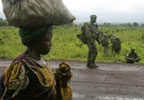
It has been 10 years since the United Nations passed a resolution recognizing the specific vulnerability of women in war and the importance of involving women in peacemaking efforts. To mark the anniversary of Resolution 1325, the U.S. Institute for Peace in Washington convened a three-day long conference covering a range of topics related to women in conflict, paying special attention to the plight of women in Congo. Of all the regions across the world currently mired in conflict, Congo was chosen as the major focus because it is seen as largely symptomatic of the changing nature of war, the undue burden conflict places upon women, and the ways in which the world confronts violence.
Between 2002 and 2006, the international community worked to end the Second Congo War and build lasting peace in the country and the region. This effort has proven to be largely ineffective in eastern Congo as conflict continues to rage and violence, especially the use of rape as a weapon of war, persists. According to Séverine Autesserre, assistant professor of political science at Barnard College and a panelist at Friday’s conference, sustainable peace was not achieved largely because peace was pursued on a national and regional level, but attention was not placed on reconciliation at the local level between individuals, families, and communities.
Local grievances—political, social, and economic stakes that are distinctively local— heavily influence the conflict in eastern Congo, according to Autesserre. Without giving attention to tension over land rights and access to lucrative minerals, sustainable peace cannot be achieved. International peacebuilding initiatives all too often pigeonhole actors into pursuing only top-down approaches rather than also engaging with the grassroots, where conflicts originate and erupt.
It is imperative to begin peacemaking efforts by “looking inside the box,” as another panelist, Raymond Gilpin of the United States Institute of Peace, suggested. Importing top-down approaches from other conflict areas cannot comprehensively address the specific issues facing the Congolese population. The international community should work with and support civil society organizations already working in the region. These actors are integral to achieving sustainable peace because they understand the pulse of the conflict, the multiple dimensions of its origins, and the havoc it wreaks upon communities. The U.S. government should continue to support regional development and the establishment of a mineral certification process, which will both reduce violence in the region and help create the room and stability for local peacemakers to operate.
The conflict situation on the ground is complex. Without a multifaceted approach that harnesses the power, passion, and innovation of grassroots actors, lasting peace will continue to elude the region. In Congo, the international community must break free from the restraints of peacebuilding strategies that put inequitable emphasis on national and regional actors, and instead forge a meaningful dialogue with those real agents of change already working on the ground.
Photo: A woman in eastern Congo passes soldiers on the road (AP)

